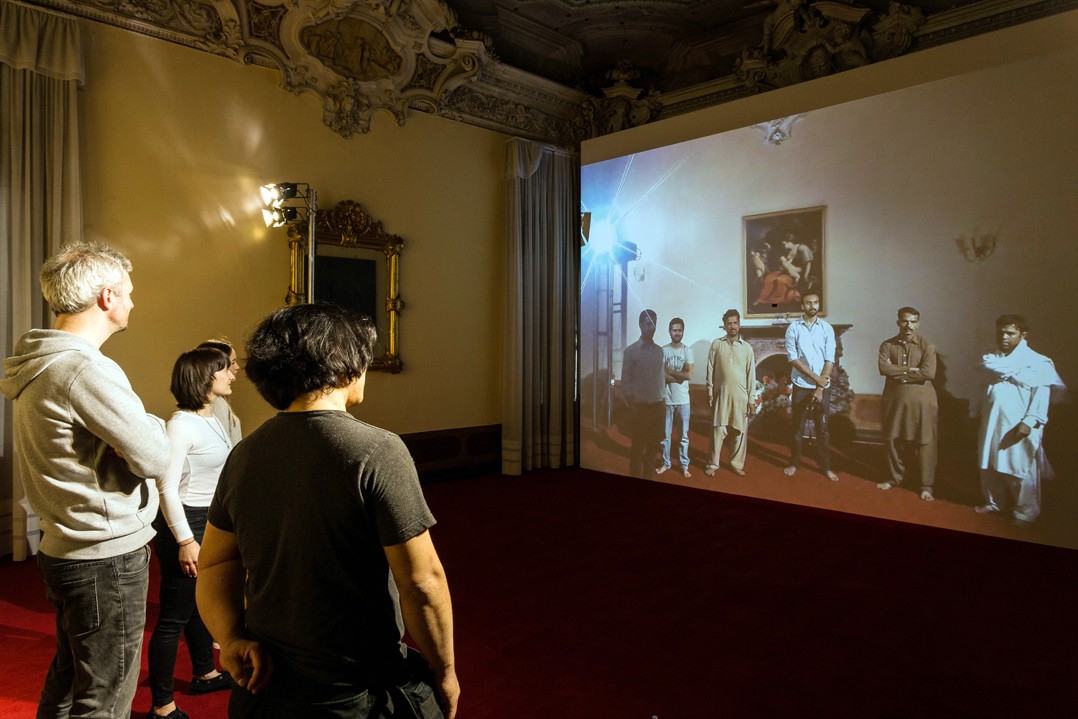
Both Rashid Rana and Shilpa Gupta deal with the concept of separation between art and life in the recently concluded show in Venice Biennale

To be or not to be. The most oft-quoted line from literature is perhaps as applicable to the world of visual arts, a world divided in defining what is art and what isn’t. And these are not just critics but ordinary viewers, collectors and artists too.
This debate becomes important because we are expected to admire works of arts displayed at galleries and collected in private houses. But we are also exposed to a whole range of visuals that are not thought of as art and could be considered so in the coming years. Like frescos, mosaics and other types of mural paintings which are now cherished as art but were commodities once, composed for a certain function. Likewise, idols for worship from African tribes to China, Japan and India are now a part of museums and admired as great works of art.
Another example of this thin line between art and non-art is the layers of graffiti and wall-chalking seen in our cities. These include political, social and medicinal messages scrawled in hurry on top of each other. For a passer-by, these may convey messages of different kinds but, to a person interested in art, these can present samples of spontaneity, purity and pictorial possibilities. In fact not long ago, artists in Karachi used walls of the metropolis as their canvases in ‘Imagining the Walls of Karachi’ project, and some of them employed the language/style of graffiti.
While Karachi was painted in all shades of colours, including red, the work of Rashid Rana presented another aspect of art in urban space. Concluded on October 2, 2015 it unfolded a number of aspects crucial to our existence including the difference or distance between art and its audience.
Art world, like other things, is fragmented into high and low art, public and private spaces, and temporal and permanent pieces. This work, the part of Venice Biennale, explored and extended these notions and classifications. Titled ‘The Viewing, The Viewer, The Viewed’, it bridged these barriers and brought ordinary people into the realm of mainstream art -- actually into one of the most prestigious international art exhibitions, the Venice Biennale. Without being condescending or patronising, Rana made it possible for ordinary folk who had never viewed an art work to come to the constructed room and communicate with complete strangers.
Here they were part of a project that challenged the questions and constructs of boundaries. The room in Liberty Market Lahore and the room from Plazzo Benzon Italy provided the rare opportunity to step out of one’s reality and enter into another realm, even if virtually. Being in that room was more like suspended in the middle space -- located somewhere in-between Italy and Pakistan. It was an intense and entertaining experience of confronting the Other, affirming that human beings even if separated through nationality, colour, gender, age or profession can find some common ground to communicate.
The other participant of Venice Biennale from South Asia, Shilpa Gupta, also addressed the idea of separation, especially partitions in the subcontinent which not only sliced land but also amputated shared history. However, the common past somehow becomes a uniform present for subversive motives and illegal activities, as terrorists as well as traders of banned items do not recognise borders between countries.
Apart from them, others too cross borders. Particularly in places where communities have common culture and language as is the case between Bangladesh and India. Shilpa Gupta has dealt with these contested grounds, where the territory turns into terror. In her work, the 3,300 kilometre long fence between the two countries, documented in a shredded hand-woven cloth as well as the blinding fog from a no man’s land preserved in a box, alluded to how these demarcations on land cause problems and yet can be conquered clandestinely.
At the Venice Biennale, Gupta created a number of drawings made with a cough syrup that is banned in one country and allowed across the border. A practice that reminds Zizek: "in the much-celebrated free circulation opened up by global capitalism, it is ‘thing’ (commodities) which freely circulate, while the circulation of ‘persons’ is more and more controlled".
Whether these are routes of illegal immigrants and smugglers, flood light that dazzles anyone standing at the edge of his country or chunks of gold, the work of Shilpa Gupta was about the separation of two countries. But it also dealt with the division of a single province, Bengal, initially cut into East and West halves, resulting in two different countries. Along with the shared past, it is the language that connects the two -- functioning as the common currency between separate or warring states. Hence, more than the national identity, it is the linguistic identity that serves as a binding entity among diverse sections of society today.
No matter how much we connect with each other through a common tongue, there is still a power of national border that is preserved in our minds, souls and text books, often under the heading of patriotism. Shilpa Gupta addressed these demarcations which once created by politicians and civil servants affect the lives and loves of millions who are dispossessed of their land and can not move freely or physically. Thus, like Palestinians, have become ‘others’ in their own surroundings.
Both Rashid Rana and Shilpa Gupta saw and made us view the Other, which lies (in both meanings of the word) beyond political borders, demarcation of art and life, and the split within one’s self.